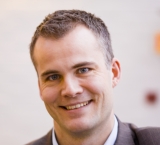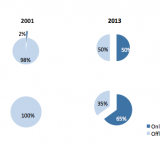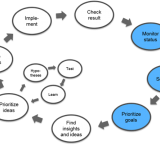FINN.no is Norway’s largest online marketplace. FINN.no is a story of disruption and innovation, and we have a goal of being one of the most innovative companies in the world. This story is about our people. The full story - people, processes and tools - can be read on the MIX-site by following this link.
FINN.no is a Norwegian company founded in 2000. The company has 400 employees and yearly revenues of 200 million USD. FINN.no is owned by Schibsted Media Group, one of Norway’s largest media companies founded in 1860. Schibsted’s business is divided into two main parts: “Classifieds” and “Media Houses”
FINN.no is a story of disruption and innovation. In the late 1990’s Schibsted decided to start a new online-company, outside the established organization, to really take advantage of the new possibilities given by the Internet. The idea was to move the newspaper classified ads online, and by that enable new revenue streams and business models. FINN.no was founded in 2000 to be that spearhead, and was given the mandate to cannibalize the newspapers business model. Now, fourteen years later, online classifieds are a major part of Schibsted’s revenue and FINN.no is one of 20+ companies in Schibsted Classified Media.

Image 1: Split of revenues and EBITDA in Schibsted Group between online and offline (i.e. print/newspapers)
Today the marketplace consists of several different categories; cars, real estate, jobs, travel, general merchandise and services/craftsmen. FINN.no is Norway’s fourth largest website (measured in unique users) and market leader in almost all categories. Measured in page views, FINN.no is Norway’s largest website with over 800 million page views per month.
FINN.no has also succeeded in establishing a revenue model based on people paying to advertise, whereas various competitors offer such listings for free. As a result FINN.no is very profitable with a profit margin above 48%.
Innovation is a strong part of our company’s history since FINN.no itself is an innovation. However, when we looked at our large market share in 2006, we saw a strong limitation for further growth. We have also seen stronger competition from global competitors like LinkedIn and Facebook. Because the Internet is such an effective distribution channel, the competition is global and highly dynamic. A startup can become a large competitor within a year, a huge contrast to the old industrial economy. Based on this analysis we decided to gear up our innovation efforts.
The most important measures we have taken to strengthen the people part of our innovation efforts are described in the following:
Culture and Values
Since we strongly believe that innovation is about people we measure and benchmark our efforts in building a culture where innovation can thrive.
FINN.no’s values are Precision, Drive, Spirit and Tolerance. The values are used actively, both as a feedback tool and as a basis for rewards and recruitment. The values are also directly linked to innovation behaviors:
- “Precision” is about learning and improvement
- “Drive” is about execution and self-empowerment
- “Spirit” is about creativity and fun
- “Tolerance” is about accepting diversity, tolerate mistakes and giving feedback
“We have a great diversity here and that demands using the value Tolerance actively. In my sales team I have a heavy rocker and a physiotherapist, not exactly the usual sales background. I find Drive and Precision natural parts of being a good salesperson, but Spirit is also actively used. We do it with humor around here and you can hear bursts of laughter all the time. I started at FINN 12 years ago when we were 25 employees. I remember back then when I thought about what the future would be. Now we are 350 employees but I still feel we have kept much of the same culture”
—Alexander Arvidsson, Sales manager
Twice a year every individual gets feedback based on how they have adhered to these values. Feedback is given by colleagues in the same team and the team manager, both in writing and orally. Oral feedback is given in group sessions facilitated by an external consultant. Every team member gets feedback from the rest of the team on what is good and what should be improved. The value “Tolerance” is used to create a good atmosphere for constructive feedback.
Once a year we organize a party called FINN Awards where prizes are given to teams or individuals in different categories, one being “Innovation of the year”. The values are used as a part of the evaluation criteria in every category.
To have an external benchmark on how we succeed in building a healthy corporate culture we have participated in Great Place to Work for the last eight years. GPTW measures elements like autonomy, freedom and influence, important building blocks for an innovative culture. We have succeeded in becoming the Greatest Place to Work twice (2011 and 2012) in Norway, and have been listed top 4 in 2006-2013. 95% of all employees say they are looking forward to go to work every day. This serves as a good benchmark, but also as a tool for strengthening employer branding. Feedback given in GPTW is actively used by the management group to adjust and prioritize actions.
Another effect of the emphasis on people and culture is employer branding. FINN.no has succeeded in becoming one of the most popular IT-companies among students. “Innovation” is also the word being mentioned the most when students in a survey made by Universum (fall 2012) were asked to say one word that comes to mind when hearing FINN.no,
“When we started FINN we brought in people with different backgrounds. Since we were going to establish marketplaces for Real Estate, Cars and Jobs we brought in people with experience from broking, car sales and recruitment. This also had an impact on culture and management. We also were rebellious and bent the rules. One prerequisite given by our owners was that we couldn’t hire salespeople. We hired “marketpeople” and used them as sales staff”
—Christian P. Halvorsen - CEO
Goals
Autonomy must have direction, without direction individuals and teams will end up working on what they define as important not what is important for the company. We have defined a high-level process to visualize the connections between goals and where teams and individuals have different levels of autonomy. The blue circles are management tasks: monitor status and set goals. When goals are prioritized and understood, teams or individuals can go about finding insights, generate ideas and finding the right actions to implement. When actions are implemented, results can be checked to see if the goal is obtained. If not, a new round of insights, actions and implementation is carried out.
By clarifying that management/leadership is about setting goals/directions and that teams and individuals should define and implement the right actions, you enhance autonomy on team and individual level but also ensure the whole organization works in the same direction.

Personal Drive
Each year we arrange the FINNovation-day, a 24-hour idea hackaton. FINNovation day is all about creativity and playfulness. All employees can attend, last year almost 20% attended. The output can be ideas and concepts that can be implemented, but the purpose of the day is mainly to offer a training ground for skills and behaviors. Either you are trying to “sell” an idea or help nurture and develop an idea. The day starts off with forming teams and elaborate ideas. The teams are free to explore almost everything, both ideas that can fit FINN’s current strategy or completely “wild” ideas. The hackaton ends with a presentation and poll in front of all employees, and prices are handed out. The ideas that fit FINN’s strategy are then evaluated by the management team.
The most important aspect of the FINNovationday is the freedom to work on ideas that matter for the individual and the possibility to present it to all your colleagues and get an assessment by the management team. The FINNovation day bypass all formal “does and don’ts” and embrace engagement and autonomy.
One concrete idea that really grew into something of a game changer for FINN was our first iPad-app. A two-person team took advantage of the liberal experimentation mandate given them by the management group. Web developer Erlend Schei elaborates:
«While not being significant on FINN's roadmap, we could play a hunch on mobile apps. Exercising our freedom to experiment, we chose to go all in with iOS development with the iPad launch in 2010. Together with my boss, Eyvind Larre, we teamed up, taught ourselves iOS, and hired two summer interns. Today, the apps team consists of 10 persons, and mobile is key in all development. »
Intrapreneurship
To strengthen the innovation culture and to foster an intrapreneurial skillset we have launched a concept called Sandbox.
Sandbox is a concept that allows employees to develop their own products based on data from FINN.no. FINN.no, being an online marketplace, has lots of user data and Sandbox enables the use of some of these datasets. Employees sign a contract with FINN.no allowing them the use of data. When a product is launched, any revenue is split 70/30 (Employee/ FINN.no). Besides from the potential upside, a Sandbox-contract also gives access to a range of support: ads on FINN.no, help from the innovation team, access to server and development-tools and Schibsted’s payment platform.
Sandbox may foster competitors to FINN.no, but we believe that the benefits of intrapreneurship overshadow the fear of competition. It is also a useful tool to support autonomy and involvement. If someone has a great idea, but it doesn’t fit our current strategy, they can be given the opportunity to launch it as a Sandbox initiative. As a “Sandbox’er” you are a true entrepreneur, and no strings are attached when it comes to processes and tools.
15 employees have signed a Sandbox-contract and last year the first solution was launched and is available in Apple App Store.
“As a developer I have used Sandbox to build a product called GrabIT. It is now available on Apple’s AppStore. I believe FINN has a strong culture of a flattened management structure and colleagues eager to help. My five minute drop-in meeting with the SVP of Product Development saved me weeks in waiting time, him an unnecessary meeting and FINN hour of administration, going up and down the organizational hierarchy.”
—Jon Georg Berntsen – system developer
Experiments
To succeed in building an innovation culture, and to learn more about the unknown, experiments are one of the most important building blocks. We also use experiments to strengthen autonomy. If an experiment doesn’t require a lot of effort, or jeopardize the customer experience, it can be conducted without authorization. The beauty of an experimental culture is that you optimize learning and limit the fear and shame connected to failure. An experiment is built around a hypotheses, and hypotheses either stand or fall. In any case you have learned something, and this learning is valuable. If people are encouraged to conduct experiments, without formal authorization-processes, but with a requirement to share learning, you can enhance autonomy.
To make use of experiments in a structured way we have tried Lean Startup in several projects:
“In the first lean startup project at FINN we experienced that the fear we had that our major customers wouldn’t be willing to experiment was exaggerated. The limited time, effort and cost involved for our partners combined with maximum learning and no commitment to launching the product made it a rather easy sell. We were open about that it was all about learning and that we might scrap the product idea. Another effect was that the speed needed to conduct experiments showed that we needed to improve the interface between sales and development. In the next project we will put more effort in involving sales earlier in the project”
—Adne Skjelstad – Product manager
Some key lessons learnt:
- Innovation is a result, not a process
- Innovation can be enabled by technology, but must be achieved by people. Even if we are a part of a tech-intensive industry we firmly believe that technology alone cannot achieve what we aim for. FINN has 100+ developers, but even if we attract the best developers our competitive advantage in many ways lies in our ability to build face-to-face relations with our customers and truly understand their needs. The internet is a highly effective distribution channel, but it also enables users to migrate to other solutions quickly. Relations cannot only be made and managed online. In addition to all the company-wide efforts described in the previous chapters, we therefor see our sales staff as a tool to succeed with innovation
- The prerequisites for innovation must be understood by managers on all levels. Management principles must support innovation. Previously we had an organizational structure that amplified suboptimal behaviors. In this perspective there was a wide range of management principles and behaviors. This was a good strategy in a growth-phase, but the profound challenges we now face calls for a stronger “FINN first” principle than before
- The problem is not the lack of ideas or creativity, but the ability to execute
- Idea generation needs direction. If you want ideas with impact you need a clear problem definition and a clear problem owner that can take ownership for execution
We believe that many of the measures we have described are context-related and many of them are intertwined. Other companies will experience other effects and have other lessons to share if they implement the same measures.
Harvard Case Study N9-707-474, April 04 2007 - Schibsted
http://engageinnovate.wordpress.com/2012/06/15/finn-no-gets-innovation/





You need to register in order to submit a comment.